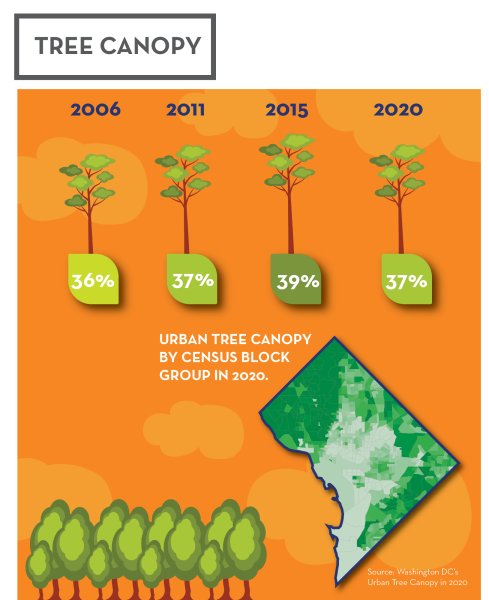

 Restoring and protecting natural habitats in the District enhances air and water quality, mitigates stormwater issues, safeguards biodiversity, combats climate change impacts such as extreme heat and flooding, and provides human health benefits. Given the District’s highly urbanized landscape and anticipated population growth, a delicate balance must be struck between development and preserving natural resources.
Restoring and protecting natural habitats in the District enhances air and water quality, mitigates stormwater issues, safeguards biodiversity, combats climate change impacts such as extreme heat and flooding, and provides human health benefits. Given the District’s highly urbanized landscape and anticipated population growth, a delicate balance must be struck between development and preserving natural resources.
The District includes more than 6,500 acres of parkland managed by the National Park Service and 851 acres of green space managed by the District Government, according to the Department of Parks and Recreation's Ready2Play. Collaborating closely with federal landowners is therefore crucial for maintaining the robust network of parks that has led the District to be consistency recognized as having the #1 park system in the United States. In addition to robust green space, the District is home to two tidal rivers, the Potomac and the Anacostia, which are undergoing major restoration efforts after long histories of pollution, habitat destruction, and negative community perception. Through work on protecting and restoring the natural environment, the District can improve the quality of life for its residents and natural inhabitants.
Goal 1: Protect, restore, and expand aquatic ecosystems
Status:  The average progress score of actions under this goal is between “Moderate Progress” (2 out of 4) and “Significant Progress” (3 out of 4). See annual progress reports for details.
The average progress score of actions under this goal is between “Moderate Progress” (2 out of 4) and “Significant Progress” (3 out of 4). See annual progress reports for details.
What's Been Done?
- The Department of Energy and Environment has completed and is pursuing stream restoration projects in the Anacostia, Potomac, Oxon Run, and Rock Creek watersheds.
- Stormwater regulations adopted in 2013 required various types of low impact development strategies in waterfront developments and renovations.
- The Green Area Ratio regulation requires a certain amount of green space on new developments and major renovations.
- The Department of Energy and Environment performed a District‐wide inventory and functional assessment of wetlands, identified wetlands that may benefit from restoration or enhancement, and created a wetland registry to improve project planning and site selection for potential restoration efforts. The wetland registry was updated to include submerged aquatic vegetation survey results and additional stream mapping, and renamed the Aquatic Resources Registry.
What is Left to Do?
- Plant and maintain an additional 150 acres of wetlands in targeted Conservation Opportunity Areas.
- Partner with developers to incorporate living shorelines in waterfront developments.
- Reduce threats to 75 aquatic species of greatest conservation need.
Goal 2: Protect, restore, and expand land ecosystems
Status:  The average progress score of actions under this goal is between “Moderate Progress” (2 out of 4) and “Significant Progress” (3 out of 4). See annual progress reports for details.
The average progress score of actions under this goal is between “Moderate Progress” (2 out of 4) and “Significant Progress” (3 out of 4). See annual progress reports for details.
What's Been Done?
- District agencies and partners regularly plant thousands of trees citywide each year.
- The Department of Energy and Environment and District Department of Transportation have established meadows on public spaces, such as alongside New York Avenue in the Fort Lincoln neighborhood.
- The Department of Energy and Environment, in partnership with the District Department of Transportation, Department of General Services, and Office of Contracting and Procurement developed the Environmental Specification Guidance for Native Landscaping. This document provides language to be inserted into contracting documents to utilize native plants in landscaping outside the right‐of‐way.
- The District Department of Transportation specifies mainly native plants in its projects and analyzes tree species to select for plantings with consideration for which species are native nearby and may be more tolerant of future anticipated climate conditions.
- The Department of Energy and Environment leads the National Capital Partnership for Regional Invasive Species Management to plan and implement invasive plant projects in the District. Participants in the Department of Energy and Environment’s River Corps Program also regularly remove invasive plant species.
- The Department of Energy and Environment worked with federal and sister agencies to establish habitat corridors from within and connecting to neighboring jurisdictions, based on data on animal collisions, expert opinion, and knowledge of critical habitats.
- In 2023, the District began a two-year ecological restoration project on Kingman and Heritage Islands, the District’s first conservation area.
What is Left to Do?
- Remove invasive plants on 500 acres of critical habitat based on a strategic management plan.
- Create or restore a minimum of 200 acres of meadow habitat.
- Incorporate biodiversity and the use of native plants in green infrastructure on District Government land.
- Create a habitat connectivity plan to guide restoration of viable, native habitats throughout Washington, DC and in coordination with surrounding jurisdictions.
- Require the District Government to use native plants and trees in all landscaping and green infrastructure outside the roadway right-of-way.
Goal 3: Improve human access to and stewardship of nature
Status:  The average progress score of actions under this goal is “Moderate Progress” (2 out of 4). See annual progress reports for details.
The average progress score of actions under this goal is “Moderate Progress” (2 out of 4). See annual progress reports for details.
What's Been Done?
- The District Department of Transportation has expanded the trail network that connects residents to natural spaces, such as the four‐mile Kenilworth Gardens segment of the Anacostia Riverwalk Trail and the Klingle Valley Trail.
- RiverSmart Homes auditors provide residents with information about native plants and their benefits.
- The Department of Parks and Recreation organizes programs at recreation centers and on-site at its community gardens and urban farms to encourage gardening skills.
- The Anacostia Green Boats program allows residents to reserve kayaks and canoes free of charge to explore the Anacostia River’s Kingman Lake while removing trash and debris.
What is Left to Do?
- Improve the formal trail network for hiking and biking—prioritizing areas east of the Anacostia River—while balancing protection of habitat.
- Increase the number of “nature play spaces” at District playgrounds.
- Create or improve small parks and natural spaces in underserved areas.
- Provide informational resources on backyard wildlife habitats, native plant gardening, container and vertical gardening, and creating pollinator habitats.
- The District Government will incorporate nature into the places we live, play, and work, to reduce stress and improve health—known as biophilic design.
Last updated: June 2025

